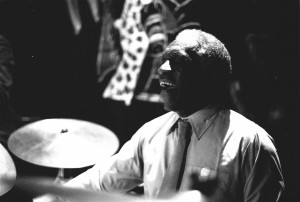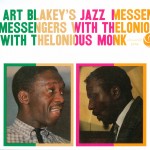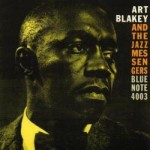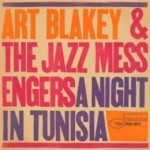“I’m gonna stay with the youngsters. When these get too old I’ll get some younger ones. Keeps the mind active.” – Art Blakey (1954)
In a career that spanned more than 40 years in jazz master drummer Art Blakey, also known by his Islamic name of Abdullah Ibn Buhaina (Bu), stuck tenaciously to that principle in practise and consequently the “alumni” of his “university” reads like a dictionary of the greatest names in the jazz history of the period from the mid-50s to the mid-80s.

Art Blakey in concert with The Jazz Messengers at Plougonven (Bretagne, France) in 1985. Photo by Roland Godefroy
Especially those musicians associated with the music often called “hard bop” almost exclusively were Jazz Messenger graduates. The names of Horace Silver, Lee Morgan, Wayne Shorter and others come to mind as players who struck out in a new direction after their experiences with the vitality and dynamism of the Blakey outfit.
One album which stands out for me in this regard is Morgan’s wonderful The Sidewinder, which can be seen as introducing “funk” into jazz.
Blakey himself was known as a sometimes explosive rhythm man who drove his musicians with tremendous energy and commitment.
In an interview with Ben Sidran published in Sidran’s book Talking Jazz (Pomegranate, 1992) Blakey explained his approach:
“I teach musicians to look at it this way. You are, in fact, you’re in the nude. You’re in your birthday suit. People can see clean through you. Your music, your actions and your vibes that you bring forth to the audience come out, and you cannot hide that. It’s got to be right. It’s got to be cohesion, it’s got to be love.”
Blakey was born in 1919 in Pittsburgh, Pennsylvania and by his teens was playing piano and leading a band. His switch to drums came about because he despaired of ever being able to compete with Errol Garner as a pianist.
The great drummer taught himself to play the drums and, some said, went to Africa in 1947 to find out more about African drumming. He indeed used certain techniques associated mainly with African drumming like rim shots and using his elbow on some drum heads to alter the pitch.
Blakey himself said of the trip to Africa:
“I didn’t go to Africa to study drums – somebody wrote that – I went to Africa because there wasn’t anything else for me to do. I couldn’t get any gigs, and I had to work my way over on a boat. I went over there to study religion and philosophy. I didn’t bother with the drums, I wasn’t after that. I went over there to see what I could do about religion. When I was growing up I had no choice, I was just thrown into a church and told this is what I was going to be. I didn’t want to be their Christian. I didn’t like it. You could study politics in this country, but I didn’t have access to the religions of the world. That’s why I went to Africa. When I got back people got the idea I went there to learn about music.” – Art Blakey, quoted by Herb Nolan in Down Beat, November 1979, p.20. (quoted in “Chronology of Art Blakey” http://www.jazzdiscography.com/Artists/Blakey/chron.htm accessed 30 August 2011)
Blakey’s attitude to music was one almost of reverence: “… to me the bandstand is hallowed ground,” he told Sidran. “You come up here, you’re supposed to play.”
His advice to new musicians: “You come on the bandstand, look professional, be sharp. They (the audience) see you before they hear you, and don’t come up there looking like something that jumped out of the garbage can, or like you gonna give somebody a grease job. …I think that they must learn to have more respect for the audience.”
As he warned against using the music “to educate” people: “Because the music is supposed to wash away the dust of everyday life. So they’re supposed to come in there and enjoy themselves. So if they start feeling like they need to be educated, then it’s not interesting any more.”
In 1947 Blakey organised a group called the “Seventeen Messengers” as a rehearsal band. An octet grew out of this band and was called the “Jazz Messengers,” and recorded. This name only stuck to Blakey’s group when in 1954 he co-led a group with pianist Horace Silver. In this group were tenorist Hank Mobley, trumpeter Kenny Dorham, and bassist Doug Watkins. The group recorded Horace Silver and the Jazz Messengers, the album recorded and produced by Rudy van Gelder and issued by Blue Note.
Blakey went on to record almost 500 albums, many of them live, a process he pioneered. As he told Sidran, “I went to Blue Note and I asked them. They thought I was crazy. I said, ‘Let’s try it. Let’s do it. Right there with the live audience.’” The wonderful three-record set of A Night at Birdland of 1954 was the result, to be followed by many live albums by the Messengers and other jazz musicians.
In addition to pioneering recordings Blakey also, as mentioned earlier, produced some outstanding “alumni” – musicians who have affected the directions jazz took after the bop era.
These “alumni”, to mention just some, included pianists Wynton Kelly, Joanne Brackeen, Kenny Drew, Keith Jarrett, Mulgrew Miller, Horace Silver, Bobby Timmons, Cedar Walton; some reed players who were Blakey alumni were Kenny Garrett, Lou Donaldson, Benny Golson, Johnny Griffin, Billy Harper, Branford Marsalis, Jackie McLean, Hank Mobley, Wayne Shorter, Jean Toussaint, Bobby Watson; among the trumpeters who learned part of their trade with Blakey were Terence Blanchard, Clifford Brown, Donald Byrd, Kenny Dorham, Freddie Hubbard, Chuck Mangione, Wynton Marsalis, Lee Morgan, Valery Ponomarev; bassists included Jymie Merritt, Curly Russell, Doug Watkins, Wilbur Ware, Reggie Workman, Stanley Clarke.
Probably no other jazz musician has influenced directly so many musicians who went on to in turn become great jazz influencers, except perhaps for Duke Ellington and Miles Davis who both ran bands that produced great musicians.
Some of the albums
With around 500 albums in his catalogue there are undoubtedly some fluffs as well as some really outstanding works of art. Here are three that I personally like particularly.
 Art Blakey’s Jazz Messengers with Thelonious Monk:
Art Blakey’s Jazz Messengers with Thelonious Monk:
This 1957 album is outstanding for, among other things, the incredible interplay between Monk’s spare and rhythmic piano and Blakey’s artful (to coin a phrase!) drumming. The empathy between the two is remarkable and led the editors of the Penguin Guide to Jazz on CD, LP and Cassette (Penguin, 1994), Richard Cook and Brian Morton, to call this album “Absolutely indipensable jazz” and to accord it their rare “Crown” accolade. The playing of all the musicians on this date is superb and the album as a whole gives undiluted pleasure to the listener. A real gem of an album. In addition to Monk and Blakey the musicians on this outstanding album are Bill Hardman on trumpet, Johnny Griffin on tenor and Spanky DeBrest on bass.
 Moanin’:
Moanin’:
This 1958 album opens with pianist Bobby Timmon’s great, bluesy number which gave the album its title, “Moanin'”. Thereafter there are four songs by the tenor-player Benny Golson and the album ends with an upbeat version of the lovely Harold Arlen and Johnny Mercer son “Come Rain or Come Shine”. An outstanding track is “The Drum Thunder (Miniature) Suite” which gives Blakey wonderful opportunity to demonstrate his skills. All the musicians involved in this album are great, but for me trumpeter Lee Morgan is the star here. Bassist Jymie Merritt rounds off the personnel list. In charge of the recording machinery was the legendary Rudy van Gelder and the producer was Alfred Lion.
 Night in Tunisia (the 1960 album):
Night in Tunisia (the 1960 album):
Art Blakey and the Jazz Messengers really give Dizzy’s tune, the title track, some superb playing. This incarnation of the Messengers, always the breeding ground for jazz stars, was exceptionally great: Lee Morgan on trumpet, Wayne Shorter on tenor, Bobby Timmons on piano and Jymie Merritt on bass, with, of course, Blakey himself keeping it all together from the drum kit. With a line-up like that, what could one expect besides some of the greatest jazz to be found anywhere? It was recorded and released in 1960. This just happened to be one of the first jazz albums I ever bought, back in about 1965, and I have loved it ever since. Again Rudy van Gelder and Alfred Lion in charge of recording and production respectively.
